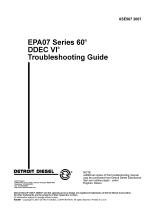
PAGE 14 — HTXG6DF RIDE-ON TROWEL• OPERATION MANUAL — REV. #4 (05/11/20)
SAFETY INFORMATION
ALWAYS tie down equipment during transport by
securing the equipment with straps. Inspect straps to
make sure they are not frayed or damaged.
CAUTION
Check with your local county or state safety
towing regulations, in addition to meeting
Department of Transportation (DOT)
Safety Towing Regulations, before towing
your trowel.
In order to reduce the possibility of an accident while
transporting the trowel on public roads, ALWAYS make
sure the trailer that supports the trowel and the towing
vehicle are mechanically sound and in good operating
condition.
ALWAYS shutdown engine before transporting
Make sure the hitch and coupling of the towing vehicle
are rated equal to, or greater than the trailer “gross
vehicle weight rating.”
ALWAYS inspect the hitch and coupling for wear. NEVER
tow a trailer with defective hitches, couplings, chains, etc.
Check the tire air pressure on both towing vehicle and
trailer. Manufacturer recommends that trailer tires be
infl ated to 50 psi cold. Also check the tire tread wear
on both vehicles.
ALWAYS make sure the trailer is equipped with a safety
chain.
ALWAYS properly attach trailer’s safety chains to towing
vehicle.
ALWAYS make sure the vehicle and trailer directional,
backup, brake and trailer lights are connected and
working properly.
DOT Requirements include the following:
• Connect and test electric brake operation.
• Secure portable power cables in cable tray with tie
wraps.
The maximum speed for highway towing is 55 MPH unless
posted otherwise. Recommended off-road towing is not
to exceed 15 MPH or less depending on type of terrain.
Avoid sudden stops and starts. This can cause skidding,
or jack-knifi ng. Smooth, gradual starts and stops will
improve towing.
Avoid sharp turns to prevent rolling.
Trailer should be adjusted to a level position at all times
when towing.
Raise and lock trailer wheel stand in up position when
towing.
Place chock blocks
underneath wheel to prevent rolling
while parked.
Place support blocks underneath the trailer’s bumper to
prevent tipping while parked.
Use the trailer’s swivel jack to adjust the trailer height to
a level position while parked.
ENVIRONMENTAL SAFETY/DECOMMISSIONING
NOTICE
Decommissioning is a controlled process used to safely
retire a piece of equipment that is no longer serviceable.
If the equipment poses an unacceptable and unrepairable
safety risk due to wear or damage or is no longer cost
effective to maintain (beyond life-cycle reliability) and is to
be decommissioned (demolition and dismantlement),be
sure to follow rules below.
DO NOT
pour waste or oil directly onto the ground, down
a drain or into any water source.
Contact your country's Department of
Public Works or recycling agency in your
area and arrange for proper disposal of
any electrical components, waste or oil
associated with this equipment.
When the life cycle of this equipment is over, remove
battery and bring to appropriate facility for lead
reclamation. Use safety precautions when handling
batteries that contain sulfuric acid.
When the life cycle of this equipment is over, it is
recommended that the trowel frame and all other metal
parts be sent to a recycling center.






























